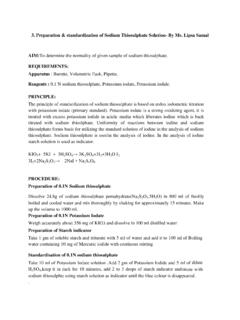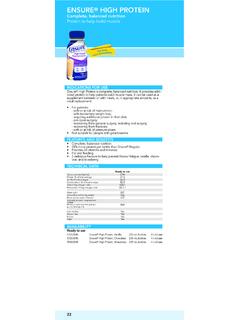Transcription of Sodium laurilsulfate used as an excipient - Europa
1 30 Churchill Place Canary Wharf London E14 5EU United Kingdom An agency of the European Union Telephone +44 (0)20 3660 6000 Facsimile +44 (0)20 3660 5555 Send a question via our website European Medicines Agency, 2018. Reproduction is authorised provided the source is acknowledged. 9 October 2017 EMA/CHMP/351898/2014 corr. 1* Committee for Human Medicinal Products (CHMP) Sodium laurilsulfate used as an excipient Report published in support of the Questions and answers on Sodium laurilsulfate used as an excipient in medicinal products for human use (EMA/CHMP/606830/2017) * Deletion of the E number. Please see the corrected Annex for further details. Sodium laurilsulfate used as an excipient EMA/CHMP/351898/2014 corr. 1 Page 2/18 Sodium laurilsulfate used as an excipient Table of contents Executive summary.
2 3 Introduction .. 4 Scientific discussion .. 4 1. Characteristics .. 4 Category (function) .. 4 4 Use in medicinal products .. 5 Regulatory status .. 5 2. Pharmaco-toxicological data .. 6 Acute toxicity studies .. 6 Repeat-dose toxicity .. 6 Genotoxicity .. 6 Carcinogenesis .. 6 Reproductive and developmental toxicity .. 6 Local tolerance .. 7 3. Pharmacokinetics (in humans) .. 7 ADME (absorption, distribution, metabolism, elimination) .. 7 Interactions .. 8 4. Clinical safety data .. 9 Use: routes of administration, range of concentrations .. 9 Adverse effects .. 9 Safety in special populations .. 12 5. Risk assessment and thresholds .. 14 6. Information for the package leaflet .. 16 References .. 17 Sodium laurilsulfate used as an excipient EMA/CHMP/351898/2014 corr.
3 1 Page 3/18 Executive summary This document and the related questions and answers [32] have been written in the context of the revision of the Annex of the European Commission Guideline on Excipients in the label and package leaflet of medicinal products for human use [3, 20]. Sodium laurilsulfate (SLS) is an alkaline, anionic surfactant. In medicinal products, SLS has a number of functional uses as an emulsifying agent, modified-release agent, penetration enhancer, solubilising agent, tablet and capsule lubricant. SLS is not used in parenteral products. There is currently no EU regulatory guideline or recommendations in place relating to the acceptable levels of SLS in medicinal products. The scope of this safety assessment is limited to medicinal products applied to the skin or the scalp, such as creams, ointments, gels and shampoos, which contain SLS.
4 Authorised medicinal products contain SLS at concentrations ranging from w/w ( creams) to 25% w/v (in medicated shampoos). The number of topical products using SLS as an emulsifier is expected to be low, only of all products licensed in the UK contain SLS. Reported adverse reactions to SLS in topical pharmaceutical formulations are skin irritation following prolonged application. The skin irritancy is thought to be due its surfactant properties, producing disruption of cell membranes and conformational changes of proteins. In addition, disruptions of the skin barrier by several mechanisms have been described including a direct action on corneocytes leading to their swelling in size, denaturation of keratin structures via direct binding, elevation of stratum corneum pH and alteration of lipid synthesis in this layer, possibly as a result of local pH changes.
5 There is a paucity of data in humans on the dermal absorption, metabolism, distribution and excretion of SLS, however, in vitro studies indicates limited penetration into the dermis. Some dermal studies have been conducted in rats but it should be noted that relative to humans, the rat skin is relatively more permeable and has a greater propensity to metabolise xenobiotics compared to other mammals. Overall, the amount penetrating into human skin and entering the systemic circulation is expected to be very low, and the fraction that reaches the systemic circulation is likely to be metabolised in a similar manner to fatty acids. A large number of publications attest to the skin damaging properties of SLS applied on its own, however case studies on formulated products are rare. The skin effects are more pronounced in patients with eczematous conditions.
6 When used in cleaning products designed to be washed off quickly, such as shampoos and soap, SLS rarely displays any adverse events. Skin sensitivity to SLS varies according to the concentration of SLS, contact time, patient population and experimental approaches. Furthermore, attempts to elucidate the skin irritation threshold in humans is found to be dependent upon the site of the application, the vehicle in which SLS is dissolved, the method of application, duration and frequency of application, the duration of the study, the presence of other skin-irritating excipients and whether the application is under occlusion. Recommending a threshold for SLS in topical products is difficult to establish given the range of confounding factors. However, it is known skin irritant and is used as a positive (irritant) control in the cosmetic industry.
7 This review recommends a threshold of zero for SLS be applied to topical products for all age groups. Sodium laurilsulfate used as an excipient EMA/CHMP/351898/2014 corr. 1 Page 4/18 Introduction There is currently no EU regulatory guideline or recommendations in place relating to the acceptable levels of Sodium laurilsulfate (SLS) in medicinal products. The vast majority of SLS use is in oral products (tablets and capsules) where it rarely displays any adverse reactions. It is not recommended for the injectable or ophthalmic routes. Reported adverse reactions to SLS in pharmaceutical formulations are skin irritation following topical application. The skin irritancy is thought to be due its surfactant properties, producing disruption of cell membranes and conformational changes of proteins. SLS (also known as Sodium dodecyl sulfate or Sodium lauryl sulfate) is an organic compound with the formula CH3(CH2)11 OSO3Na.
8 In medicinal products, SLS has a number of functional uses in pharmaceutical preparations as an emulsifying agent, modified-release agent, penetration enhancer, solubilising agent, tablet and capsule lubricant. SLS is not used for parenteral preparations. Being derived from inexpensive coconut and palm oils, SLS is a common component of many domestic cleaning products such as hand soaps, washing-up liquid etc. SLS is not a permitted food additive in the European Union. The scope of this safety assessment is limited to topical products such as creams, ointments, gels and medicated shampoos applied to the skin or the scalp that contain SLS. This review will not cover its use as an excipient for other dosage forms or routes of administration ( tablets and capsules, liquids for oral administration or toothpastes), or where SLS is used as active ingredient ( laxative enema preparations).
9 Scientific discussion 1. Characteristics Category (function) Anionic surfactant; emulsifying agent; modified-release agent; penetration enhancer; solubilising agent; tablet and capsule lubricant. Properties SLS is a mixture of Sodium alkyl sulfates, which according to Ph. Eur contains not less than 85% of Sodium alkyl sulfates calculated as C12H25 NaO4S Sodium dodecyl sulfate (MW=288). SLS is prepared by the sulfation of commercially available lauryl alcohol with either sulphur trioxide or chlorosulfonic acid. The product of this reaction is then neutralised with aqueous Sodium hydroxide or Sodium carbonate. Lauryl alcohol is in turn usually derived from either coconut oil or palm kernel oil by hydrolysis, which liberates their fatty acids, followed by hydrogenation. Due to the synthetic method, commercial samples of SLS are often a mixture with other alkyl sulfates, dodecyl sulfate as the main component.
10 Sodium laurilsulfate used as an excipient EMA/CHMP/351898/2014 corr. 1 Page 5/18 SLS is available commercially in powder and pellet forms. The salt is a 12-carbon chain attached to a sulfate group giving the material the amphiphilic properties required of a detergent. Sodium coco-sulfate is essentially the same compound, but made from less purified coconut oil. A related surfactant, Sodium Laureth Sulfate (SLES) is more widely used as a detergent and surfactant in personal care products (soaps, shampoos, toothpaste etc.) and in some medicated shampoos. SLES is effective over a wide pH range, both in acidic and alkaline solution and in hard water (because of the solubility of the corresponding calcium and magnesium salts no common ion effect). It differs from SLS by virtue of presence of ethoxyl groups [(OCH2CH2)n] in the backbone where n=3 or more, which is thought to give SLES extra foaming activity.














